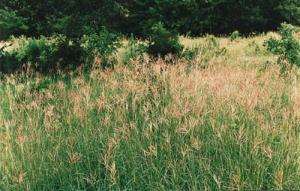By Patrick Keyser

In addition to the benefits that native grasses can provide for stockering, backgrounding, heifer development, and improved drought resiliency (see three previous articles for more information on each of these), they also can reduce exposure to fescue toxicosis. This syndrome has been estimated to cost U.S. beef producers more than $2 billion annually in losses, primarily as a result of reduced calving rates and weaning weights. The impact is estimated to be about $160/cow per year. More recent work demonstrates that toxicosis also impacts bulls, reducing their reproductive performance.
Although use of novel, non-toxic fescues and overseeding clovers are both good ways to reduce impacts of toxicosis, the use of warm-season grasses is another viable alternative. Keeping cattle off infected fescue in summer is especially beneficial because concentrations of toxins are often elevated at this time of year. Furthermore, impacts of toxicosis are compounded by summer heat stress.
Several studies have shown that stockers can experience increased gains, at least seasonally, by moving them off of tall fescue onto a warm-season forage. This is true whether the forage is a summer annual such as Sudex, bermudagrass, or old world bluestem. In a North Carolina study, steers grazing eastern gamagrass (1.91 lb per day), switchgrass (2.00 lb per day), and big bluestem (2.38 lb per day) all outgained those on a endophyte-free tall fescue/bermudagrass system (1.61 lb per day). A Missouri study reported a rate of gain of 1.36 lb per day on infected fescue for the same time period.
One study compared infected tall fescue to a system that incorporated switchgrass (20% of system acreage) for spring calving herds. Calves on the switchgrass system produced 55 lb/ac more in weaning weight than those on the infected tall fescue. Unfortunately, no other studies have evaluated integrated native grass systems for cow-calf production – they are expensive and time consuming to conduct.
However, studies have shown that heifers on infected fescue gained only about one third the weight as those on non-toxic fescues.
Click here to see more...